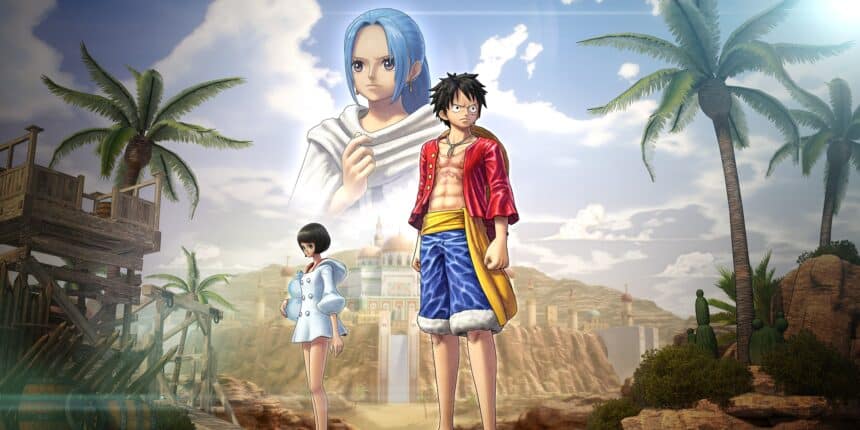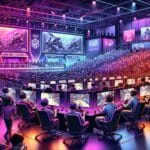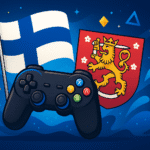One Piece Odyssey is an upcoming JRPG from Bandai Namco Entertainment and takes the infamous Straw Hat Crew to the island of Waford. I got to play 3 hours of the game and came away with a pretty positive experience where I explored the island, fought various foes, and took on a few side quests while interacting with the different NPCs. In our One Piece Odyssey preview, we take a look at how well the iconic manga and anime series works as an RPG.
Waford Island and Story Setup
Like other One Piece games, there’s a clear effort to create an experience that players unfamiliar with the universe can enjoy as well. Sure, knowing who these characters are and what their roles in the crew and relationships can definitely help, but this side adventure feels detached enough from the main story that you don’t need to know much about it.
After getting caught up in an unexpected storm, the Straw Hat crew are stranded on a pretty strange island that doesn’t abide by the laws of physics and is already showing signs of strange weather effects. Your initial goal, as Luffy, and a few others, is to locate the rest of the crew, establish yourselves and gather your wits. There’s also the matter of your powers, which this incident has drained. So ultimately, your goal is to uncover the secrets of the Island, figure out how to get your powers back, and hopefully get out.

Waford Island is full of characters to talk to and side quests to take on, and I always had something to do in the initial hours of my gameplay. Your crew talks to each other a lot and provides valuable input during quests and exploration. Dialogue and writing are quite faithful to the characters, and it essentially felt like an episode of the show. The visual variety in the opening areas was quite impressive, with a few different types of terrain. I’m curious to see where the full game takes us next and how big this really island is.

Eiichiro Oda designed two new characters for the game, whom you’ll encounter throughout the title.
Traversal and Exploration
One of the unique things about One Piece Odyssey is how you move around. Sure, you have the standard traversal mechanics you’d expect from any JRPG of the past decade, but the game allows you to swap between the crew on the fly. Each character adds something to how you traverse the area and find new items. Luffy can climb higher parts of an area by extending his arms, while Zoro can destroy different obstacles around the island to gain access to new locations or slash open crates.

These character-specific abilities aren’t limited to just traversal, though, but exploration as well. Sanji is a chef, and with him, you can find hidden ingredients that he can later use for cooking up different items. Similarly, Usopp has access to his slingshot that he can use to knock hidden items from different parts of the world that are inaccessible normally. Nami can detect money in environments, and Chopper can get into small crevices in the terrain.
I found these mechanics well ingrained in the world and made plenty of use during the opening few hours. I am looking forward to more instances of how players can utilize these. So far, these exploration and traversal mechanics have kept me engaged, and I was always on the lookout for opportunities to switch between these characters.
Combat and Positioning
One Piece Odyssey features a turn-based combat system, where four of your crew members are usually pitted against different types of enemies. Your positioning is quite important here because of its random assignment. Each character falls into a type, like Attack or Technique, and it’s important to evaluate if they even fit into this current battle. You can actually switch between the remaining crew during battles, utilizing their abilities, which could be better suited for the encounter.

I had a lot of fun playing as Zoro because his skills would target multiple enemies and did plenty of damage. However, for an enemy positioned away from me, I relied more on long-ranged characters like Usopp or Luffy.

The more I played, the more I recognized which enemies were weaker to certain attacks, and would routinely switch between the crew. Using simple attacks gives Tension Points, which are a requirement for
“Skills”. Skills are basically special attacks that do more damage, target multiple enemies, and even cause status effects.

Dramatic Scenes
During battles, you’ll sometimes be assigned a random combat objective, which the game calls “Dramatic Scenes”. This could be anything, such as defeating an enemy within a turn. Completing these provides the crew with additional rewards after the battle is over. This is something that makes you experiment a bit more, and the incentive of a higher reward keeps things interesting.

Attacks have beautiful animations and feel right out of the anime. I enjoyed seeing characters perform so many unique animations for each skill. One thing I would like to see adjusted is the blinking effect which shows you which enemies an attack will hit. The slight glow effect is a bit hard to spot, and maybe a more efficient way of showing that can make it a bit more readable.

Customization and Equipment
I previously mentioned how some characters have exploration abilities tailored to their defining characteristics from anime. This extends further to stuff like crafting and cooking. The ingredients you pick can later be used to craft neat items and equipment that will aid you through the journey and combat. The equipment works differently, too, as you’re given much more freedom with who gets to keep what.

Essentially, in Odyssey, each character can equip any item as long as it fits in a square grid, which is sort of an equipment slot. This means that you can use different items to create builds for each character and define roles for the party as you see fit.

You also find “cube fragments” items that essentially let you unlock skills for specific characters. This ties into the premise of the crew losing their powers, which you earn back with fragments. I enjoyed this system because it pushed me to explore further and take part in more combat encounters to increase my chance of finding more fragments. There is a lot to do here, and the systems work quite well with each other.
Presentation
One Piece Odyssey looks great, feels very faithful to the source material, and captures the aesthetics of the anime quite well. Characters are expressive, well designed, and animated. Enemies have the same charm you’d expect from Eiichiro Oda’s beautiful artwork and manage to strike a balance between goofy and intimidating.

The world itself is a big step up from previous One Piece titles with higher technical fidelity on display, despite the anime-styled visuals. The environment is reactive, with grass swaying, even during combat, and subtle particle effects complementing different attack animations and boosts.
It’s clear that the developers are fully using Unreal Engine 4, with a world that feels rich with detail and some great use of lighting that is especially prominent in interiors.

The UI is a bit busy for my taste and can be a bit jarring, especially if you don’t play JRPGs often. Though, I appreciate all the important information presented, even as you choose different skills to use.
Final Thoughts
Overall, the few hours I’ve put into One Piece Odyssey have been quite enjoyable and engaging. The characters are fun to hang around with, and the standalone nature of the story makes the world quite accessible for a variety of players.

Exploration and traversal are a big part of the experience, with a beautifully rendered world with charming enemies and NPCs to interact with. The dynamic nature of combat with flexibility offers a more involved system that relies on positioning and strategy with a large cast of playable characters. I’m looking forward to the full game, how each system evolves, and what mysteries Waford Island has in store.
One Piece Odyssey is coming to PC, PS4, PS5, and Xbox Series S|X on January 13, 2023.
What did you think of our One Piece Odyssey preview? Are you excited about the upcoming title? Share your thoughts in the comments below.










